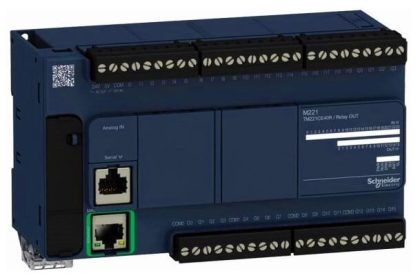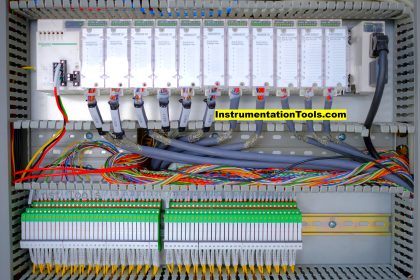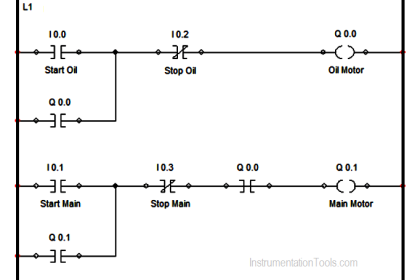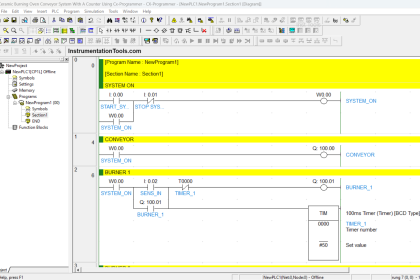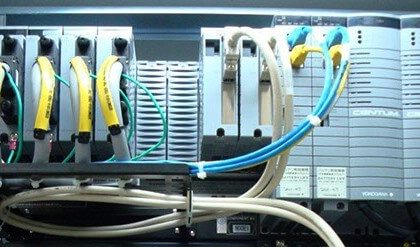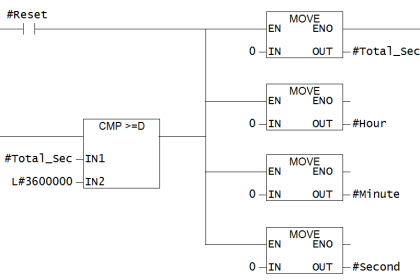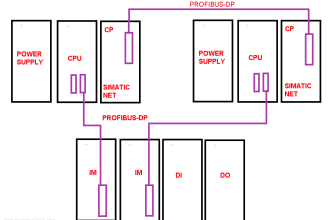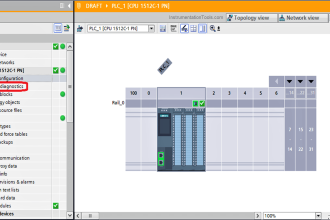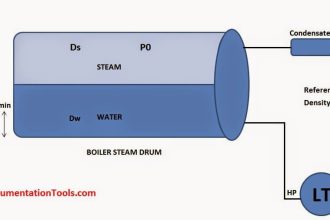Design an industrial oven control application with the PLC controller to maintain the set temperature and then cool down after some time.
Note: This PLC program is prepared for engineering students to practice the ladder logic with simple examples.
Industrial Oven Control
Problem Statement:
Design a PLC ladder logic for the following application.
We are using one toggle switch to Control Preheat, Buzzer, Set Temperature, and Cooling.
The Oven should preheat for 10 seconds, then a buzzer will turn ON. The food tray should be placed inside and then only, the buzzer will turn OFF and maintain the set temperature for 20 seconds and then cool down for 30 seconds.
PLC Controller Training
This PLC programming video explains the simple oven ladder logic.
Inputs and Outputs
Digital Inputs:
Start Button: I0.0
Digital Outputs:
Preheat: Q0.0
Set Temp: Q0.1
Buzzer: Q0.2
Cooling: Q0.3
Ladder Logic
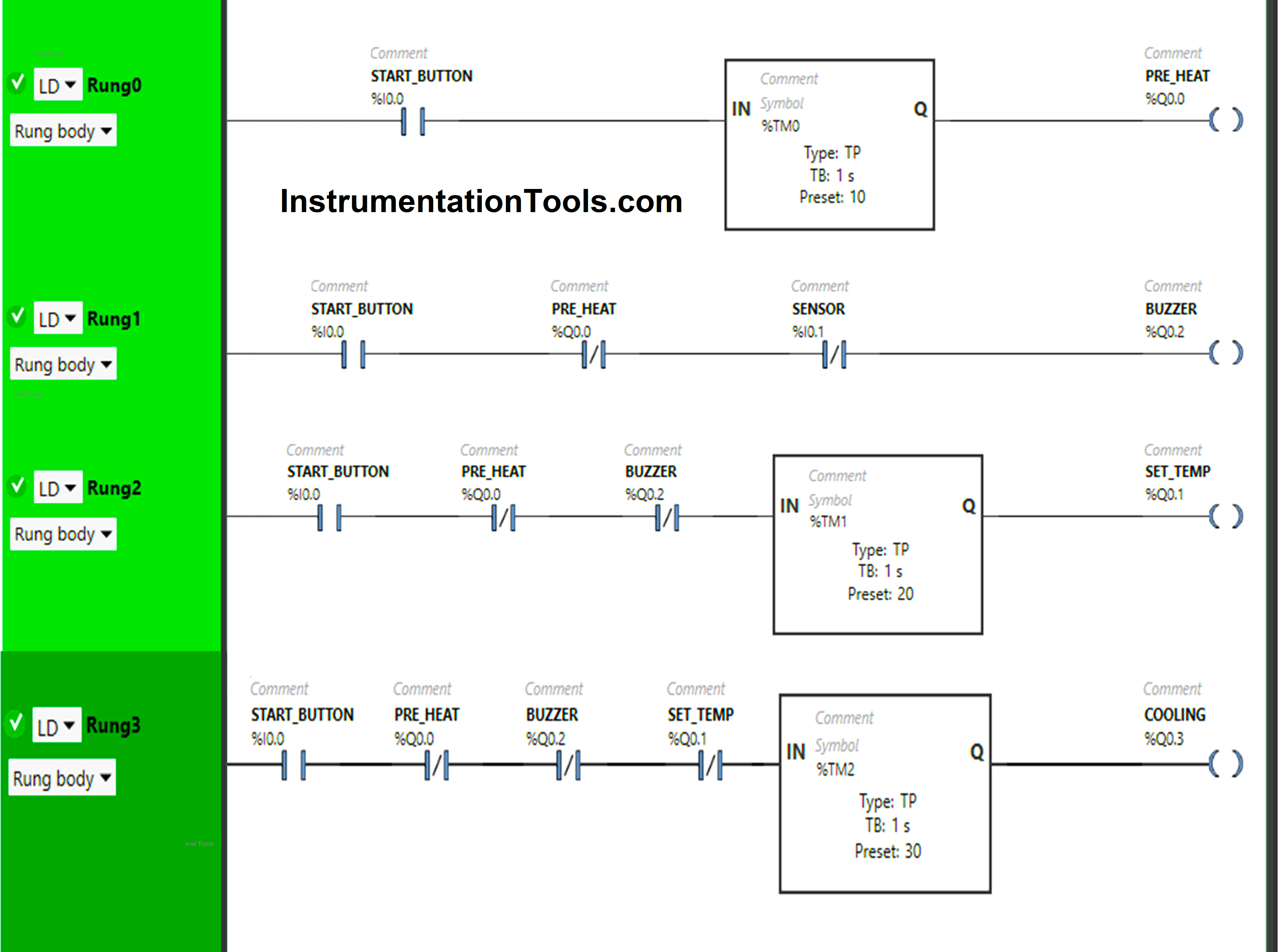
Program Description
We have used Normally Open Contact for the Start Button(I0.0).
We have used Normally Closed Contacts for Preheat (Q0.0), Sensor (I0.1), Buzzer (Q0.2), Set Temperature (Q0.1) and Cooling (Q0.3).
In Rung 0:
- Normally Open Contact is used for the Start Button (I0.0) to Turn ON the output Preheat (Q0.0).
- Timer Function Block type TP is used to Turn ON the output Preheat (Q0.0) for a limited time.
In Rung 1:
- Normally Open Contact is used for the Start Button (I0.0) to Turn ON the output Buzzer (Q0.2).
- Normally Closed Contact is used for Preheat (Q0.0) to turn ON the output Buzzer (Q0.2).
- Normally Closed Contact is used for Sensor (I0.1) to turn OFF the output Buzzer (Q0.2).
In Rung 2:
- Normally Open Contact is used for the Start Button (I0.0) to Turn ON the output Set Temperature (Q0.1).
- Normally Closed Contacts are used for Preheat (Q0.0) and Buzzer (Q0.2) to turn ON the output Set Temperature (Q0.1).
In Rung 3:
- Normally Open Contact is used for the Start Button (I0.0) to Turn ON the output Cooling (Q0.3).
- Normally Closed Contacts are used for Preheat (Q0.0), Buzzer (Q0.2), and Set Temperature (Q0.1) to turn ON the output Cooling (Q0.3).
Simulation Results
We will simulate the PLC program and analyze the results. We may show the partial logic instead of the complete PLC program.
Rung 0:
When the Start Button (I0.0) is turned ON, the output Preheat (Q0.0) turns ON (Oven starts Preheating) but for a limited time as Timer Function type TP is used to turn ON the Output Preheat (Q0.0) or Preheat the Oven for a limited time.

The time is set to 10 seconds. So after 10 seconds, the output Preheat (Q0.0) will turn OFF, or after 10 seconds Preheating of the Oven finishes.

Rung 1:
Also, when the Start Button (I0.0) is turned ON, the output Preheat (Q0.0) is OFF (Preheating of Oven finishes) and the Sensor (I0.1) gets activated (Sensor detects tray).

The output Buzzer (Q0.2) turns OFF as Normally Closed Contact used for Sensor (I0.1) will be in True state and does not allow the signal to pass through it and the output Buzzer (Q0.2) will turn OFF.

Rung 2:
When the Start Button (I0.0) is turned ON and the outputs Preheat (Q0.0) and Buzzers (Q0.2) are OFF in Rung1 and Rung2.
The output Set Temperature (Q0.1) turns ON as normally Closed Contacts used for Preheat (Q0.0) and Buzzer (Q0.2) in Rung2 will be in a false state and passes the signal to turn ON the output Set temperature (Q0.1) and the output Set Temperature (Q0.1) turns ON (Oven maintains set temperature).

The output Set Temperature (Q0.1) will turn OFF after some time as Timer Function Block type TP is used to turn ON the output Set Temperature (Q0.1) for a limited time.
The time is set to 20 seconds. After 20 seconds, the output Set Temperature (Q0.1) turns OFF (Maintaining Set Temperature ends).

Rung 3:
When the Start Button (I0.0) is turned ON and the outputs Preheat (Q0.0), Buzzers (Q0.2), and Set Temperature (Q0.1) are OFF in Rung1, Rung2, and Rung3.
The output Cooling (Q0.3) turns ON as normally Closed Contacts used for Preheat (Q0.0), Buzzer (Q0.2), and Set Temperature (Q0.1) in Rung3 will be in a false state and passes the signal to turn ON the output Cooling (Q0.3) and the output Cooling (Q0.3) turns ON (Oven starts Cooling).

The output Cooling (Q0.3) will turn OFF after some time as Timer Function Block type TP is used to turn ON the output Cooling (Q0.3) for a limited time.
The time is set to 30 seconds. After 30 seconds, the output Cooling (Q0.3) turns OFF (Cooling of Oven ends).

If you liked this article, please subscribe to our YouTube Channel for PLC and SCADA video tutorials.
You can also follow us on Facebook and Twitter to receive daily updates.
Read Next:
- PLC Programming for Washing Machine
- PLC Programming for Fish Feeding System
- Static and Temp Memory in Siemens PLC
- PLC Programming in Bottle Filling Process
- Automatic Sanitizer Ladder Logic Example
